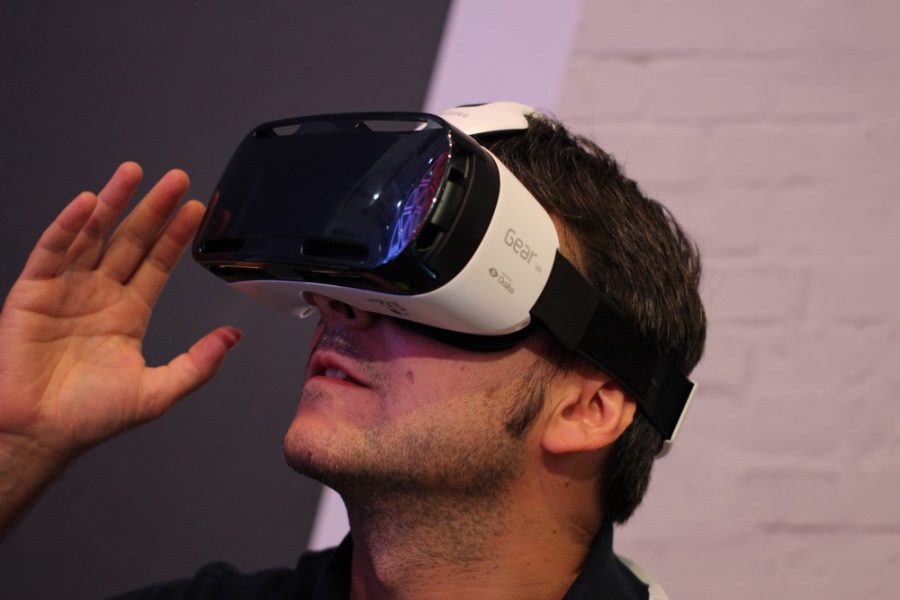Despite the vast possibilities of virtual reality, the technology still has kinks and limitations. The main issue? It has nothing to do with technical issues— try nausea and motion sickness.
A VR headset works like a television and motion sensor in one. It tracks your movements to display a 360-degree environment in relation to where you shift your vision— look up, down, left and right to reveal a pre-recorded scene that allows you a spherical panoramic view.
VR games and environments are constructed like any other game, using 3D assets and a knowledge of programming. Due to the high-powered nature of VR, however, powerful computers with up-to-date graphics chips are essential to their operation.
RELATED: Campus iSpace offers students cutting-edge tech, instruction
The power of VR lies in its ability to allow the user to experience a place or event as if one was actually there. Some real estate companies allow customers to look around a room with VR, and The New York Times publishes “The Daily 360”, through which viewers experience a much more immersive news story than from simply reading or listening to one.
The United Nations even uses the technology to build support from stakeholders by showing them VR films of the refugee crisis.
“They show them children in refugee camps, and you can go up to them, and see their story up close” said Anthony Sanchez, co-director of the iSpace tech learning facility at UA. iSpace offers VR systems for student use.
Some people also use VR as a way to overcome their fears. Someone who suffers from arachnophobia, for example, might watch a tarantula approach them without any actual threat.
VR has also proven potential as a training tool for pilots, doctors, astronauts and those learning foreign languages. NASA, for example, has developed a unity program designed to train astronauts for flight into space, and has been popular as a flight simulator for those pilots closer to earth.
But for all its potential, VR technology usage still has provides some critical challenges to overcome. For one, significant processing power is required to run the device.
“These games require a lot more processing power, there’s the wiring, and the battery doesn’t last long,” Sanchez said.
RELATED: UA math duo develops data error recovery tech
VR also has to cram high quality pictures into a small space to achieve a high resolution.
“Desktops and phones usually have a pixel display of 200 microns, whereas VR is about 10 microns, sometimes even smaller than that,” said Hong Hua, UA professor of optical sciences.
High quality images are required for VR to appear visually convincing.
“In order to perceive a 3 dimensional space, you have to render 2 images, one for your left eye and one for your right eye,” Hua said, “and then you have to offset them in order to achieve a certain depth.” By offsetting the two images, you push them to converge and perceive 3D.
Normally, your eyes focus on the same distance. If you hold your hand up in front of your face and try to look through your fingers, your hand will appear blurry. This is because human eyes usually focus on one particular ..depth at a time —when your eyes focus and converge on the same distance, this gives your brain a cue as to exactly how far away objects are.
“However, in VR, the contents [are] driving your eye to converge at a different depth while the information that allows your eye to focus is at a constant distance,” Hua said.
Imagine peering through a VR headset. While you may be perceiving images with great depth, like a mountain valley, the display screens are still physically very close to your eyes. These conflicting views are what lead to visual fatigue.
Another challenge is spatial orientation. While Most VR games limit our movement, they do usually allow for ducking and weaving. Sometimes there is a delay between our movements and the VR system accommodating for our movements, which can have great effects on our orientation, even if it’s only for half a second.
We also have a mechanism within our inner ear that tells us how we are oriented in space. When there’s a conflict between our visual cues and our spatial cues, our body tends to follow the visual cues.
“It’s not really motion sickness, it’s more of a disconnect between what your brain is seeing and what you’re doing,” Sanchez said.
VR also needs to overcome some product challenges, namely high price ($500 to $800, depending on the model) and clunky, wired design.
But despite its challenges, VR offers an unparalleled sense of immersion, and future platforms may eliminate or reduce these challenges. So with the right advances in technology, VR has the potential to revolutionize the world of media technology the same way radio and television did.
Check out VR in action at the Science-Engineering Library’s iSpace for free.
Follow William Rockwell on Twitter.















